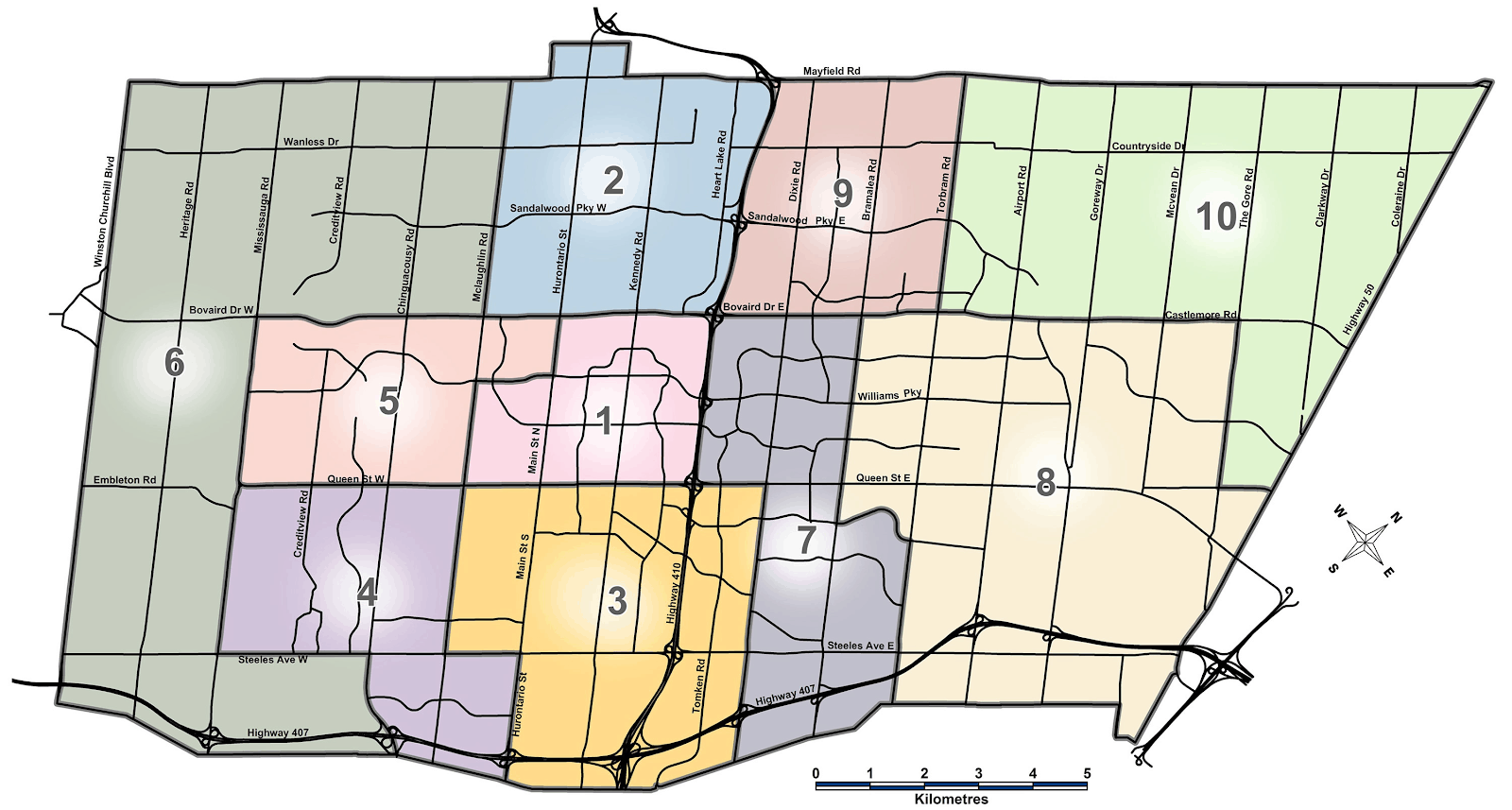Brampton councillors delay changing ward boundaries until 2026
Published July 12, 2020 at 9:35 pm

It’s almost time for one of the rather mundane but nevertheless important tasks a municipal council has to undertake: the ward boundary review.
It’s almost time for one of the rather mundane but nevertheless important tasks a municipal council has to undertake: the ward boundary review.
But in Brampton’s case, it looks like voters would have to wait until 2026 to elect councillors from new constituencies.
During a Governance and Council Operations Committee meeting last week, city councillors opted to keep the same ward boundaries for the 2022 election, choosing to implement any ward boundary changes instead for the 2026 election.
Brampton’s current municipal ward boundaries
“If we start the process now, we don’t know what the numbers in terms of Brampton’s population will be in six years from now,” said Wards 7 and 8 Councillor Pat Fortini, adding that areas such as downtown Brampton (the Riverwalk), Highway 10 and Steeles and Heritage Heights (in the city’s northwest corner) would be anticipating population growth.
The last ward boundary review in Brampton was conducted in time for the 2014 election, and the intention was to use the current boundaries for at least two more elections before revisions.
A bylaw would have to be passed by December 31, 2021 in order for ward boundary changes to take effect for the 2022 election, otherwise the changes would not come into effect until 2026.
Fortini also brought up how it was near impossible that Brampton would be able to achieve another long standing goal at this time: getting all of Brampton’s councillors also sitting at the Region of Peel, something that neighbouring Mississauga has vetoed in the past.
This point of contention was one of the driving forces of Mississauga’s hope of getting out of the Region of Peel last year, to which the Ford government opted to keep the status quo.
Earlier this year, Mississauga started their own process of a ward boundary review to be in place by the 2022 municipal election.
Citing a population forecast from Hemson Consulting, the staff report indicated that Brampton’s population would increase from 615,690 in 2016 to 890,030 by 2041, with the majority of that growth occurring in the city’s west side in Wards 4 and 6, as well as the city’s northeast in Wards 9 and 10. Another table in the report shows the population growth forecasts by election year, in 2022, 2026 and 2030.
Based on this data, the voting areas to experience the strongest population growth would be in Wards 2 & 6, Wards 3 & 4 and Wards 9 & 10.
The following tables show the population variance amongst the 10 wards in the city. 25 per cent is the generally accepted threshold. Wards 6 and 10 show a massive variance of 85 per cent and 45 per cent, indicating the future population growth.
But if there are going to be ward boundary changes, some of the options the City of Brampton is considering include:
No changes at all
This is the status quo, what Brampton’s council composition is now being divided into 10 wards, with five ward pairings. If Council opts to keep things as they are, no further action would be required.
“Each ward pairing is represented by a City Councillor and Regional Councillor, with the Mayor elected to serve at large, as well as on Regional Council. A sixth Regional Councillor is appointed by City Council at the beginning of the term of Council, from amongst the five City Councillors.”
Revisions to current ward pairings
Council may wish to keep the system of pairing two wards to be represented by a city and regional councillor, but they could propose pairing different wards based on future population growth in certain wards.
Look at Wards 2 & 6; it would seem that Ward 5 is physically closer to Ward 6 than Ward 2. Those who are running for council in that area would have to cater to communities as far north as Snelgrove all the way down to Churchville. A Wards 1 & 2 and Wards 5 & 6 pairing may make more geographic sense.
Unpair wards
Maybe it’s time for Brampton to decouple two wards from each other and just do what Mississauga, Toronto and many other cities have for council representation: one ward per councillor. The report indicated that “Council could wish to continue with the 10 ward structure, so that each councillor represents one ward only.”
There would be a new method required to elect regional councillors, and one option mentioned was that the six councillors who receive the most number of votes (total votes in percentage) in the election would be appointed to Peel Regional Council along with the Mayor.
In the last election two councillors, Rowena Santos and Paul Vicente, essentially ran “as a team” within Wards 1 & 5 and were elected. Having to run in their own respective wards would make that strategy a little harder to pull off; two people trying to run on a common platform isn’t much of a “party” at all.
The other consideration of having regional councillors appointed based on their popular vote share would mean that candidates would have to pay more attention to how many votes they get, rather than just getting enough votes to eke out a win. We may see less attempts to get councillors elected with only 25 to 30 per cent of the vote.
Align ward boundaries with provincial and federal ridingsBased on the Ford government’s hasty decision in 2018 to change the City of Toronto’s ward boundaries to match provincial / federal ridings, another idea was to use wards based on Brampton’s current five ridings used to elect MPPs and MPs.
Each ward would be represented by a city and regional councillor, with the sixth councillor being selected by the current model. Additionally, these five proposed wards could be divided in two to create 10 wards, with one councillor representing each.
The argument here would be having ‘synchronized’ representation with one MP, one MPP and two Brampton councillors representing voters and residents in the same community so as to avoid confusion for people trying to remember which area they live in and who their local representatives are.
Create a new composition with six wards
The final proposal is that Council may direct staff to create a six-ward scenario, with the election of six Regional Councillors and four City Councillors. Each Regional Councillor would represent one of the six wards.
The six wards would then be split into two groupings, for example, Wards 1, 2 and 3 as one grouping, and Wards 4, 5 and 6 as the other grouping. Two City Councillors would be elected to represent each ward grouping, such as two City Councillors serving Wards 1- 3, and two City Councillors serving Wards 4-6.
This option is based on the premise that Brampton representation at the regional level remains at six Councillors.
Although this may seem like a very, very wonkish exercise that excites only those political junkies and a narrow scope of individuals who really care about municipal governance, the very least one can see from this exercise is confirmation that population growth in the city is happening primarily in a few specific areas of Brampton.
But all in all, it’s important to know how your politicians are changing the way you elect them. In this case, 2026 in some time away which gives people ample time to learn about these impending changes.
INsauga's Editorial Standards and Policies


